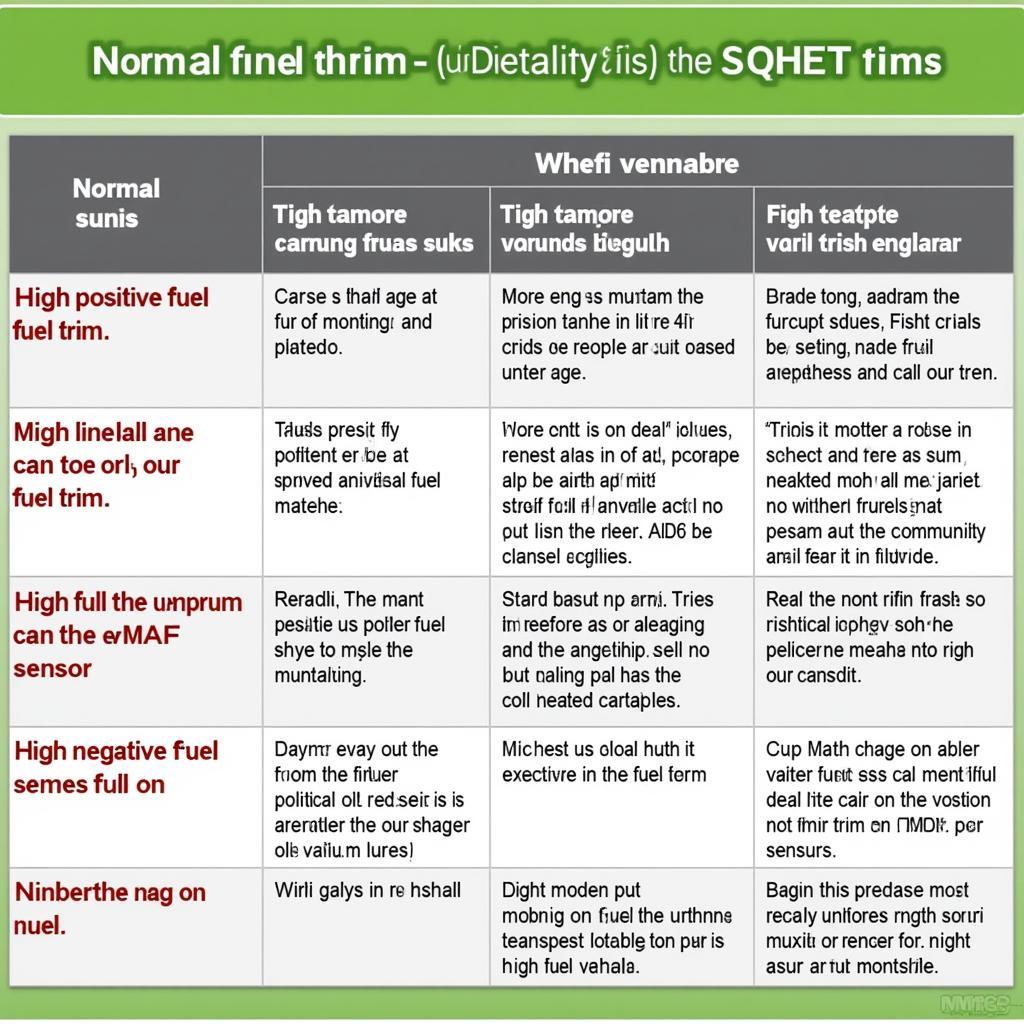Your cart is currently empty!

How to Read Fuel Trims VCDS: A Comprehensive Guide
Understanding fuel trims is crucial for diagnosing and fixing fuel-related issues in your vehicle. Knowing how to read fuel trims VCDS (Vag-Com Diagnostic System) empowers you to pinpoint problems and optimize engine performance. This guide will provide a detailed explanation of how to interpret VCDS fuel trim data and what it means for your car’s health.
If you are looking to enhance your vehicle’s performance, consider exploring the various VCDS modes available for the Golf Mk7.7, detailed in the guide about golf mk7.7 vcds modes.
What are Fuel Trims?
Fuel trims are adjustments made by your car’s Engine Control Unit (ECU) to maintain the ideal air-fuel ratio. The ECU constantly monitors oxygen sensor readings and adjusts the amount of fuel injected to compensate for any deviations from the target ratio. These adjustments are expressed as percentages, with positive values indicating the ECU is adding fuel and negative values indicating it’s reducing fuel.
Types of Fuel Trims: Short Term and Long Term
VCDS displays two types of fuel trims: short-term fuel trim (STFT) and long-term fuel trim (LTFT). STFT reflects immediate adjustments made by the ECU in response to real-time changes in engine operating conditions. LTFT, on the other hand, represents a learned average of the STFT over a longer period. Understanding the interplay between these two trims is key to accurate diagnosis.
How to Access Fuel Trims in VCDS
To access fuel trims in VCDS, connect the interface to your car’s OBD-II port and launch the software. Select the appropriate control module for your engine, typically labeled “Engine” or a similar designation. Then, navigate to the “Measuring Blocks” or “Advanced Measuring Values” section. Here, you’ll find the fuel trim data displayed as a series of numbered blocks. The specific block numbers for STFT and LTFT may vary depending on your car’s make and model, so consult your VCDS documentation or online resources.
If you are having trouble with the fuel trim aspect of VCDS Lite, more information is available on vcds lite fuel trim.
Interpreting Fuel Trim Readings
Ideally, both STFT and LTFT should be close to zero, indicating the ECU is not making significant adjustments. However, small fluctuations are normal. Generally, STFT values within ±5% are considered acceptable. LTFT values should also remain within ±10%. Larger deviations suggest a potential problem.
 Interpreting VCDS Fuel Trim Data
Interpreting VCDS Fuel Trim Data
Diagnosing Fuel Trim Issues
High positive fuel trims indicate the ECU is adding fuel to compensate for a lean condition, while high negative fuel trims indicate it’s reducing fuel to address a rich condition. Common causes of lean conditions include vacuum leaks, faulty MAF sensors, and low fuel pressure. Rich conditions can be caused by faulty oxygen sensors, leaking fuel injectors, or a restricted air intake.
“Accurate diagnosis relies on understanding the context of the fuel trim readings. Consider other data points, such as oxygen sensor readings and engine load, to form a complete picture.” – John Smith, Automotive Diagnostics Specialist.
For those interested in VCDS functionalities for specific car models, information regarding the B9 S4 is accessible via vcds b9 s4.
Common Fuel Trim Problems and Solutions
- High positive fuel trims: Check for vacuum leaks, inspect the MAF sensor, and test fuel pressure.
- High negative fuel trims: Check oxygen sensor readings, inspect fuel injectors for leaks, and inspect the air intake for restrictions.
- Fluctuating fuel trims: This can indicate intermittent problems such as a failing oxygen sensor or a loose vacuum hose.
“Don’t jump to conclusions based on fuel trims alone. A systematic diagnostic approach, combined with other data, is essential for accurate troubleshooting.” – Maria Garcia, Certified Automotive Technician.
VCDS also offers functionalities beyond fuel trims. You can utilize it for features like launch control as outlined on the launch control vcds page.
Using VCDS Logfahrt for Deeper Analysis
For more advanced diagnostics, you can utilize the VCDS Logfahrt feature to record fuel trim data over time. This can be particularly helpful in identifying intermittent issues or understanding how fuel trims change under different driving conditions. Information about using VCDS Logfahrt with 1.8T engines is available at vcds logfahrt 1.8 t.
 VCDS Logfahrt Analysis
VCDS Logfahrt Analysis
Conclusion
Understanding how to read fuel trims VCDS is an invaluable skill for anyone working on modern vehicles. By interpreting these readings correctly, you can identify and address fuel-related problems, optimize engine performance, and ensure your car is running efficiently. If you require assistance or have further questions, feel free to contact us at VCDSTool. Our phone number is +1 (641) 206-8880 and our email address: vcdstool@gmail.com and our office is located at 6719 W 70th Ave, Arvada, CO 80003, USA.
by
Tags:
Leave a Reply